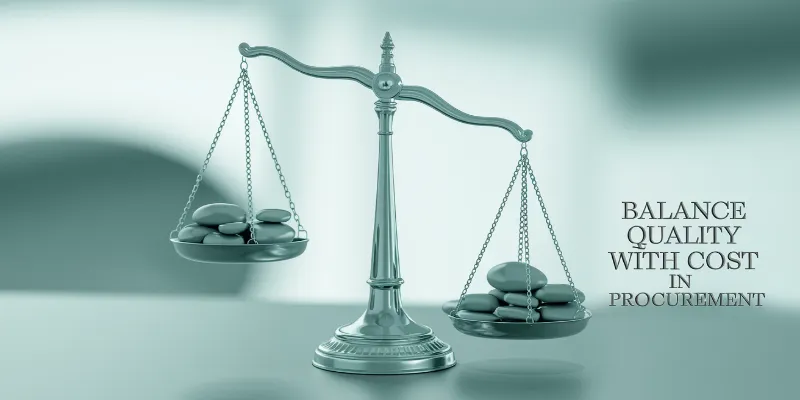
The ability to procure goods and services efficiently has become a defining factor for business success. Cost-effective procurement is not just about reducing expenses; it’s a strategic approach that balances the need for quality with the importance of nurturing strong supplier relationships. As organizations struggle to enhance their operational efficiency, they must manage the complexities of supplier selection, negotiation, and quality assurance. This delicate balance is crucial for maintaining product integrity while maximizing value.
In this blog, we will explore the essential components of cost-effective procurement, providing insights and strategies that empower businesses to optimize their procurement processes and foster lasting partnerships with suppliers.
What is Cost-Effective Procurement?
Cost-effective procurement involves acquiring goods and services in a manner that maximizes value while minimizing costs. It is a strategic approach that requires businesses to evaluate their procurement processes continually. By optimizing procurement, companies can enhance their operational efficiency, reduce overhead, and ultimately improve their bottom line.
Key Components of Cost-Effective Procurement
- Supplier Selection: Choosing the right suppliers is foundational to effective procurement. Factors to consider include price, quality, reliability, and service. A thorough evaluation process can help identify suppliers that offer the best overall value.
- Negotiation Skills: Effective negotiation can lead to favorable pricing and terms. Understanding the supplier's perspective and being prepared with data and alternatives can strengthen your position during negotiations.
- Bulk Purchasing: Consolidating orders and making bulk purchases can lead to significant cost savings. Many suppliers offer discounts for larger orders, making this an effective strategy for lowering per-unit costs.
- Total Cost of Ownership (TCO): This approach considers not only the purchase price but also additional costs associated with acquiring a product, including shipping, handling, storage, and disposal. Understanding TCO helps organizations make more informed purchasing decisions.
- Technology Integration: Utilizing procurement software and tools can streamline processes, improve visibility, and enhance communication with suppliers. Automation can reduce errors and save time, leading to cost savings.
How Can You Balance Quality with Cost in Procurement?

Balancing quality and cost is essential for sustainable procurement. Organizations should focus on obtaining the best value rather than merely the lowest price. This involves assessing the total cost of ownership (TCO), which includes purchase price, maintenance, and disposal costs. Establishing clear quality standards and specifications can help guide procurement decisions, ensuring that quality is not compromised for cost savings.
What Strategies Can Help Maintain Quality in Procurement?
To maintain quality while managing costs, businesses can implement several strategies:
- Set Clear Quality Standards: Define specific criteria that products must meet before purchase, and communicate these to suppliers.
- Conduct Supplier Audits: Regularly assess suppliers' production processes to ensure compliance with quality standards.
- Utilize Performance Metrics: Establish key performance indicators (KPIs) to monitor supplier quality and performance, enabling informed decision-making.
Also Read : Costs of Manufacturing in Mexico
How Do You Build Strong Supplier Relationships?
Building strong supplier relationships is crucial for effective procurement. Start by fostering open communication, providing feedback, and ensuring transparency in dealings. Long-term partnerships can lead to improved pricing, better service, and collaborative problem-solving. Regular check-ins and updates can help strengthen these relationships.
What Tips Can Strengthen Supplier Relations?
Here are some tips to enhance supplier relations:
- Recognize and Appreciate Contributions: Acknowledge suppliers’ efforts and successes, fostering goodwill.
- Collaborate on Improvement Initiatives: Work together on projects aimed at enhancing quality and efficiency.
- Maintain Regular Communication: Keep lines of communication open to address concerns and share insights.
How Can Risk Management Enhance Procurement Processes?
Effective risk management in procurement helps identify and mitigate potential risks that can disrupt supply chains or impact costs. By anticipating challenges such as price volatility or supply chain disruptions, organizations can develop contingency plans and make informed decisions that protect their interests.
What Risk Management Strategies Should Be Implemented in Procurement?
Consider implementing the following risk management strategies:
- Supplier Diversification: Engage multiple suppliers to reduce dependency and mitigate risks associated with supply chain disruptions.
- Market Intelligence: Regularly monitor market trends and economic indicators to anticipate potential risks and adjust procurement strategies accordingly.
- Contingency Planning: Develop contingency plans for critical items, including identifying alternative suppliers and maintaining safety stock.
Must Read: List Of Manufacturing Companies In Mexico
Cost-Effective Procurement Strategies with SIXM

Cost-effective procurement is a delicate balance between minimizing expenses and ensuring quality while maintaining strong relationships with suppliers. By strategically selecting suppliers, leveraging negotiation skills, and prioritizing quality, businesses can achieve significant savings without sacrificing the integrity of their products or services. This balance is particularly crucial when considering Mexico sourcing & procurement services, where local expertise can further optimize procurement outcomes.
Investing in technology and fostering collaborative supplier relationships will not only enhance procurement processes but also create a competitive advantage in the market. As businesses navigate the complexities of procurement, the focus should remain on creating value that benefits both the organization and its suppliers. By striking this balance, companies can build a resilient procurement strategy that supports sustainable growth and success.
At SIXM, we understand the challenges businesses face in optimizing procurement processes. Our expertise in supplier relations and market analysis can help you unlock new efficiencies and drive meaningful savings. Partner with us to enhance your procurement strategy and secure the future success of your business. Together, we can turn procurement into a powerful driver of value and growth.

